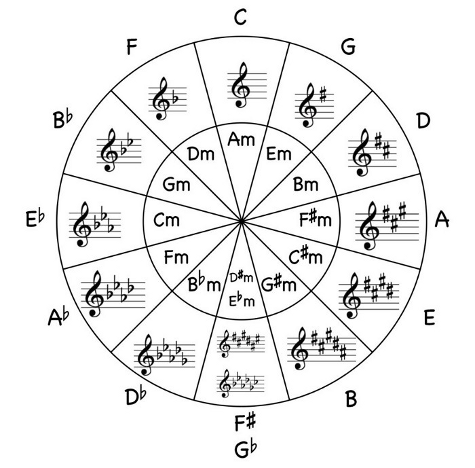We start our study of music theory as it relates to guitar playing with the major scale, which is the most important scale in Western music. It is the basis of most music theory and can be thought of as music’s primary building block.
Understanding the major scale is a prerequisite to understanding how the various chords and scales are constructed and how they relate to each other.
This post will cover how to construct a major scale. It will also provide a common fingering for the scale, along with instruction on how to play it on a guitar in any key.
Scales in General
A scale is a progression of notes that follows a specific pattern of whole steps and half steps.
A half step is the smallest distance between two notes, the distance of one fret on a guitar. A whole step is the distance of two frets.
For example, there is a half step between the notes E and F (fig.1, highlighted in red) and a whole step between the notes A and B (fig.1, highlighted in blue).
Fig.1

The specific pattern of whole steps and half steps in a scale determines the type of scale it is and how it sounds.
The Major Scale
The major scale is a seven-note scale with the following pattern of whole steps and half steps: whole, whole, half, whole, whole, whole, half (W W H W W W H).
The scale can start on any note but always follows the same pattern. The note it starts on gives the scale its specific name.
For example, if we start a major scale on a C, we have a C major scale. If we start one on a G, we have a G major scale.
C Major Scale
A C major scale contains the notes C, D, E, F, G, A and B (fig.2). The eighth note in the scale (C) is the same as the first note an octave (eight notes) higher.
Fig.2

It is easy to see the pattern of whole steps and half steps in the scale if we play it horizontally (on one string) on a guitar (fig. 3).
Fig. 3

If we start a C major scale on the C on the fifth string, third fret, you can see that there is:
- A whole step between C and D.
- A whole step between D and E.
- A half step between E and F.
- A whole step between F and G.
- A whole step between G and A.
- A whole step between A and B.
- A half step between B and C.
All Other Major Scales
If we start a major scale on any note other than C, we will need to raise (sharp) or lower (flat) one or more of the notes a half step to maintain the major scale pattern of whole steps and half steps.
G Major Scale
For example, in a G major scale an F# is required to maintain the pattern. A G major scale contains the notes G, A, B, C, D, E and F# (fig.4).
Fig.4

Again, we can play the scale on one string to see the pattern of whole steps and half steps (fig. 5).
Fig. 5

If we start a G major scale on the G on the sixth string, third fret, you can see that there is:
- A whole step between G and A.
- A whole step between A and B.
- A half step between B and C.
- A whole step between C and D.
- A whole step between D and E.
- A whole step between E and F#.
- A half step between F# and G.
The Cycle of Dominants
While it’s important to understand how to construct a major scale, fortunately there a aid that tells us which notes are sharp and which notes are flat in each of the 12 major scales. This aid is called the Cycle of Dominants (fig.6).
Fig.6
The Cycle of Dominants

The letters on the outside of the circle represent the root notes of the 12 major scales. The key signatures inside the circle tell us which notes are sharp or flat in each major scale.
The chord symbols on the interior of the circle can be disregarded for now.
D Major Scale
The Cycle of Dominants tells us that in a D major scale, the F and the C are played sharp.
So a D major scale contains the notes D, E, F#, G, A, B and C# (fig.7).
Fig.7

F Major Scale
The Cycle of Dominants tells us that in an F major scale, the B is played flat.
So an F major scale contains the notes F, G, A, Bb, C, D and E (fig.8).
Fig.8

All 12 Major Scales
All 12 major scales are shown in fig.9. The Gb and F# major scales are enharmonic equivalents (the same scale with the notes spelled differently).
Fig.9



Major Scales on a Guitar
A common fingering for a major scale is shown in fig.10.
Fig.10

This fingering will allow you to play a major scale — through two octaves — starting on any note:
- To play a C major scale, start the pattern on the C on the sixth string, eighth fret (fig.11a).
- To play a G major scale, start the pattern on the G on the sixth string, third fret (fig.11b).
Fig. 11

Scale Quality and Application
A major scale sounds bright and is used to solo over major chords and major key chord progressions.
Related Posts
Related posts include:
